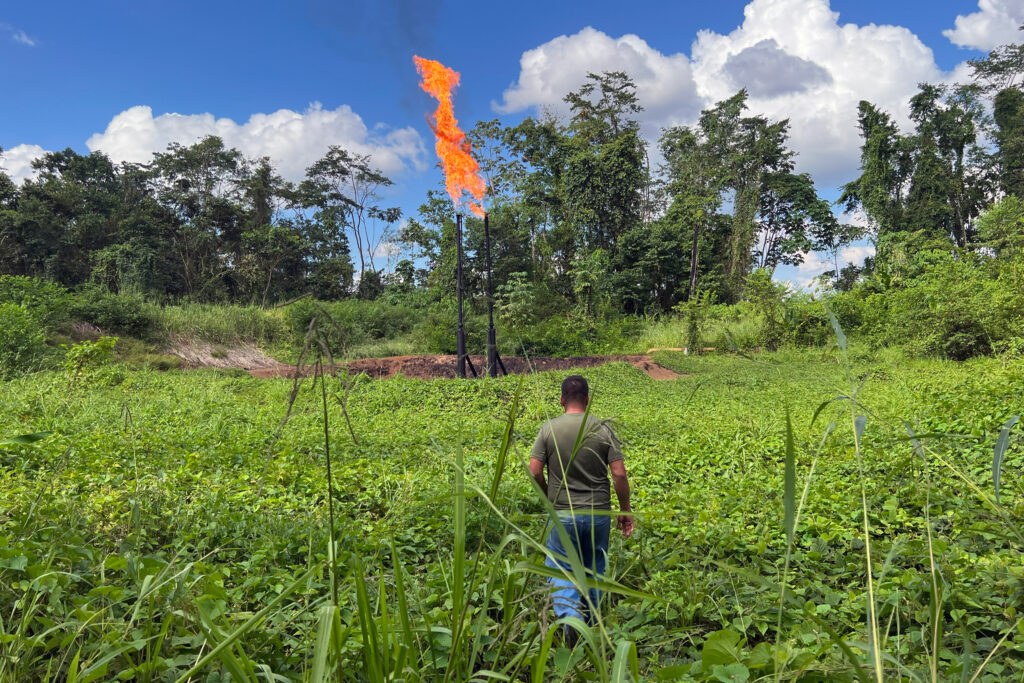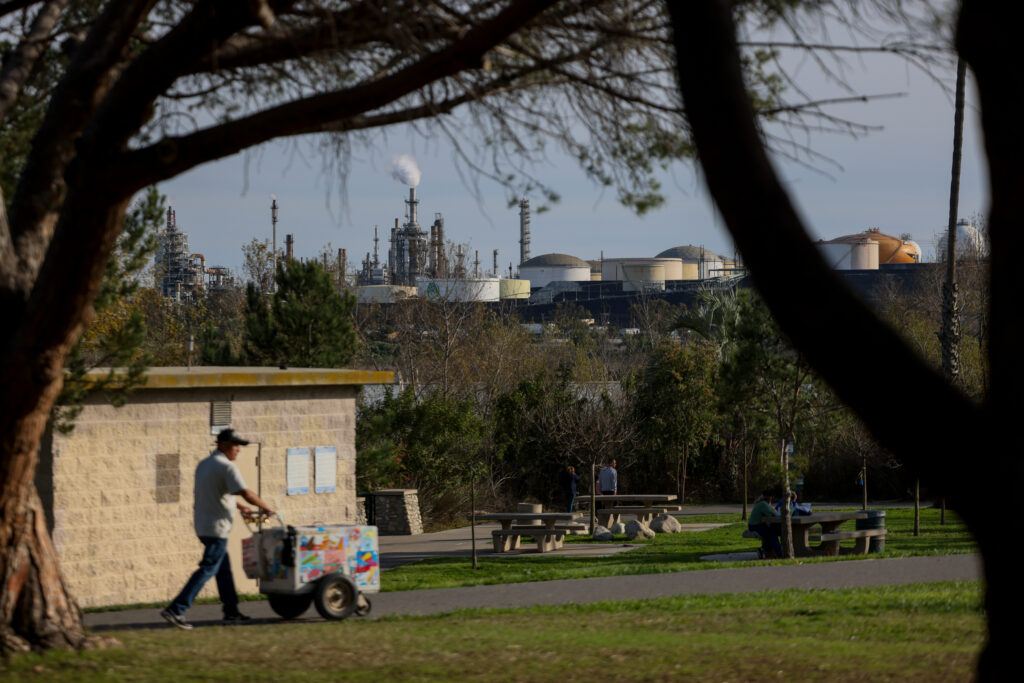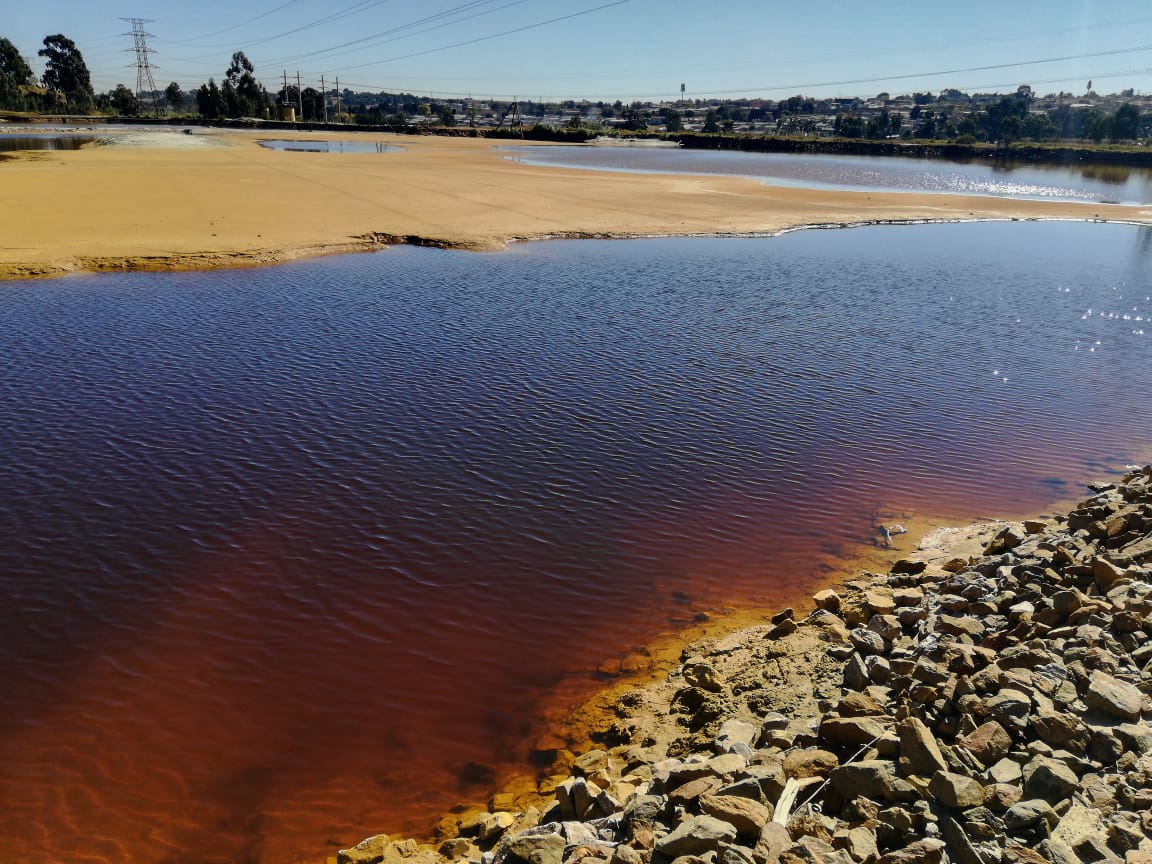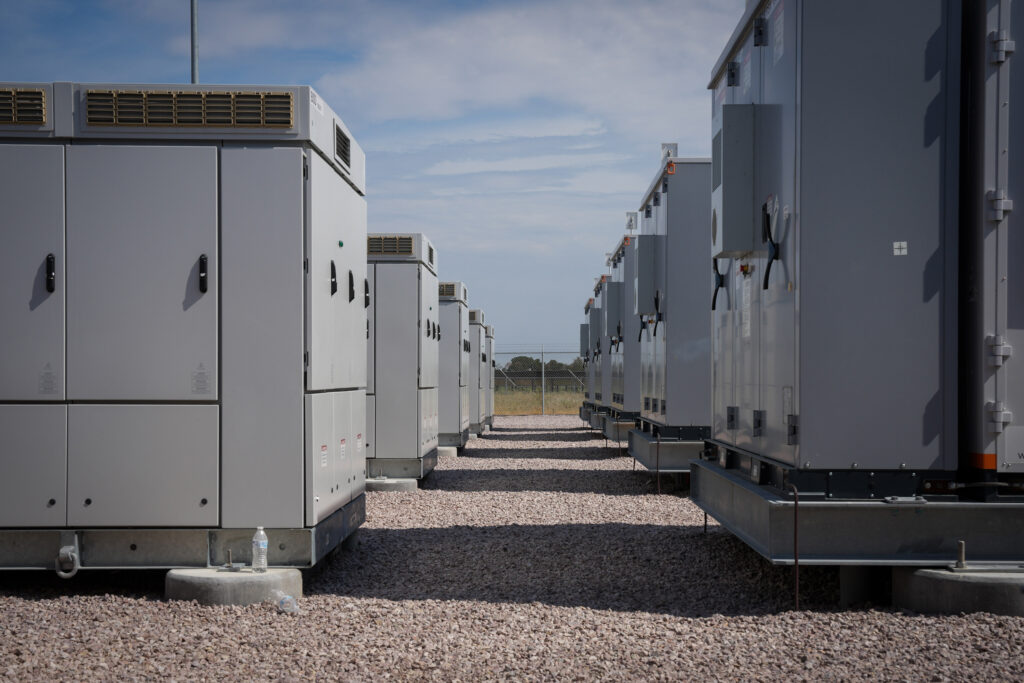Driving home from work late on April 25, Leah Thomas noticed the sky over Beaver County was glowing red.
“At first I thought maybe it was a fire, or that something was burning,” she said.
As she got closer, she realized the light was coming from the Shell ethane cracker plant, a huge plastics manufacturing site that sits along the Ohio River about 30 miles northwest of Pittsburgh.
“I was shocked. I couldn’t believe how bright it was,” said Thomas, who lives about three miles from the plant. “My entire yard was lit up almost like it was early morning, like dawn.”
For some residents of Beaver County, the Shell plant’s light, noise and air pollution has disrupted their daily lives ever since it officially began operations in the fall of 2022. Although Shell paid $10 million in fines for air quality violations in 2023, people living near the plant say the pollution has only gotten worse since then—and it’s been especially bad in the last few weeks. The increased activity hasn’t translated into more communication from the company or the Pennsylvania Department of Environmental Protection, further alarming residents.
On April 22, Shell wrote on Facebook that the plant will be “starting a unit this week which will cause increased utilization of our site flares,” warning that this action “may result in brighter light from our ground flares that could be enhanced by low cloud cover or weather conditions.” Past flaring incidents at Shell were the result of malfunctions at the plant.
On April 25, the company said it would start using the “elevated flare this afternoon” and expected the work to continue throughout the weekend. Shell promised to post an update “once available.” That was the last message about the flaring until May 7, when the company again posted that it would ramp up flaring as it started a unit.
When reached for comment, Shell spokesperson Natalie Gunnell said by email that the company “continues to keep the community informed of significant site activities via social media, community events, and public notifications.” Shell did not respond to questions about the cause of the flaring.
But DEP records provided to Inside Climate News show the plant reported a malfunction on April 25. In a call with DEP on April 28, Shell’s environmental manager, Kimberly Kaal, said the flaring was a “safety event” caused by maintenance work. Shell found debris in the plant’s equipment, prompting a ramp down and restart. She said the flaring event would continue “for another week.”
In a statement, DEP spokesperson Brandon Glass said Shell alerted the department on April 25 that “a maintenance outage was taking longer than expected and that some flaring would occur during the restart.”
DEP inspected the Shell plant on April 28, Glass said on Friday, and subsequently issued an air quality notice of violation “associated with the malfunction(s) and cumulative emissions which had resulted in intermittent visible emissions.”
“DEP continues to monitor the matter,” he said.
Thomas wasn’t the only one who saw the strange light that night and the following nights, when the dark sky was again streaked in otherworldly orange. Others captured images of eerie clouds hovering over their roofs and beyond the tree line, pictures of what looks like a fiery sunset in the middle of the night. The light shone in Beaver Falls, Chippewa Township, Moon Township, Aliquippa and Ohioville.
Residents in Beaver County saw “large orange clouds” and “red flares so bright I mistook it for the northern lights” in the night sky, according to records of complaints made to the DEP during this time frame.
“The sky looks like it’s on fire,” one resident said. Another said: “The light pollution from the plant is growing worse. It’s not natural and needs to stop.”

“I opened my back door and it was like a zombie apocalypse had hit the Earth,” said Hilary Starcher-O’Toole, the executive director of the Beaver County Marcellus Awareness Community, a grassroots environmental group that closely monitors the plant. “I can’t even begin to tell you what that’s like, when it was a nice day out, and we’re coming into summer, and then you walk outside and it’s like, ‘Why? What did we do to deserve this? You think you’re living your best small-town American life, and you see that—it’s really scary.”
Starcher-O’Toole lives in Center Township, four miles from the plant. She said she and her husband smelled a “burnt plastic” or acrid odor that night, and her organization received photographs of the light from all over the county. She also heard reports of sounds “like a jet engine” coming from the plant and from at least two residents who sought medical attention: one for respiratory symptoms and one for a severe headache. “Our social media accounts were just blowing up,” she said.
DEP complaint records show residents reported strong smells and a slew of symptoms in the wake of the flaring, from coughs to migraines and sinus irritation.
Residents say the only communication they received from the company during this incident were the two Facebook posts. Shell uses its Facebook page for updates about its operations, and residents say that’s not enough: Many people don’t use Facebook or think to check it. They worry about what will happen if an emergency knocks out internet service.
That night, Starcher-O’Toole drove closer to the plant. After parking across the river from the site, she encountered neighbors who were also looking for answers. One of them asked her whether she knew if there was an emergency.
“It really should be Shell’s responsibility to reach out to us or to the community,” she said. “We all deserve an answer. We deserve to know what’s going on.”
The DEP maintains a web page for information about the plant, but key sections haven’t been updated since September 2024. There have been at least 16 inspections and 10 notices of violation issued by the department since then, none of them listed on this site.
Those notices of violations were issued to Shell between Jan. 23 and March 25 for visible emissions, rolling emissions violations and NOx exceedances. NOx stands for nitrogen oxides, a group of air pollutants that contribute to smog. DEP said Shell has reported four malfunctions so far in 2025.
This story is funded by readers like you.
Our nonprofit newsroom provides award-winning climate coverage free of charge and advertising. We rely on donations from readers like you to keep going. Please donate now to support our work.
Donate Now
The agency said it most recently inspected the Shell plant on April 28 and conducted a site observation the following day. Although DEP found “no observed issues” on April 29, a complaint received by the department on May 2 said the flaring had continued, as Kaal had said it would. “I have never seen this many consecutive flaring days,” the resident wrote. “Please help us! Something is wrong!!”
A DEP air quality inspector sent this message to residents who complained: “Flaring of emissions is the appropriate and required pollution control system for Shell Chemicals. The flares reduce air emissions by 98-99%. The flares are in operation at all times and may be more visible at night creating the ‘orange glow.’ The Department does not regulate any light pollution caused by the flares.” However, he wrote, the “visible emissions were most likely a violation” of the plant’s current permit.
According to the EPA, flaring “can produce some undesirable by-products including noise, smoke, heat radiation, light, sulfur oxides (SOx), nitrogen oxides (NOx)” and carbon monoxide.
Starcher-O’Toole said DEP has often declined to send inspectors out after dark, meaning that they missed when the plant appeared to be most active. “We have a really great need to have someone in the Beaver County area who can respond to these things much faster,” she said.
The DEP spokesperson said the agency does send inspectors out at night “as needed.”
Clifford Lau, a chemist and volunteer with the Beaver County Marcellus Awareness Community, said he noticed more flaring and increased activity at the plant throughout April and into May. In April, the plant’s fenceline continuous air monitoring system detected elevated levels of volatile organic compounds, harmful gases, for 21 days in a row. The exceedances reached a peak on April 19 of more than 760 parts per billion. The threshold for triggering an investigation is 46.
As of May 9, Shell had not yet released the results of its biweekly passive air monitoring system collection for the end of April. The latest results are dated April 9. This data records levels of chemicals like benzene, naphthalene and toluene. In April 2023, Shell had a documented leak of benzene, a known carcinogen.
DEP said four state air monitoring stations in the vicinity of the Shell plant did not record any daily exceedances between April 23 and 26.
In years of monitoring Shell, this is the most active Lau has seen the plant. “It is definitely not what we’ve typically seen before,” he said. Lau wonders if this level of activity represents a new normal as the plant climbs toward full operational capacity. “Is this what we have to look forward to?” he asked.
Thomas said she moved to her current home in April 2022, when it was “peaceful and quiet.” After September 2022, when operations began at Shell, she and her husband began to notice changes: lights, smells, flaring.
“I can say with confidence, if I had known that the Shell plant was so active, I probably wouldn’t have moved to this home,” she said. “It is scary to know such a place is so close to my home.”
About This Story
Perhaps you noticed: This story, like all the news we publish, is free to read. That’s because Inside Climate News is a 501c3 nonprofit organization. We do not charge a subscription fee, lock our news behind a paywall, or clutter our website with ads. We make our news on climate and the environment freely available to you and anyone who wants it.
That’s not all. We also share our news for free with scores of other media organizations around the country. Many of them can’t afford to do environmental journalism of their own. We’ve built bureaus from coast to coast to report local stories, collaborate with local newsrooms and co-publish articles so that this vital work is shared as widely as possible.
Two of us launched ICN in 2007. Six years later we earned a Pulitzer Prize for National Reporting, and now we run the oldest and largest dedicated climate newsroom in the nation. We tell the story in all its complexity. We hold polluters accountable. We expose environmental injustice. We debunk misinformation. We scrutinize solutions and inspire action.
Donations from readers like you fund every aspect of what we do. If you don’t already, will you support our ongoing work, our reporting on the biggest crisis facing our planet, and help us reach even more readers in more places?
Please take a moment to make a tax-deductible donation. Every one of them makes a difference.
Thank you,

















